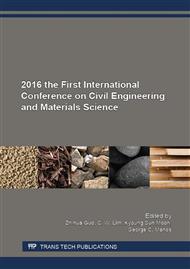p.63
p.68
p.73
p.78
p.83
p.88
p.94
p.99
p.109
Performance Using Boiler Ash Clinkers as Replacement for Course Aggregates in Concrete
Abstract:
Palm oil industry in Malaysia has a phenomenon grow in recent years and this caused lots of oil palm waste generated while the boiler ash clinker (BAC) is one of the waste that left over after burning of the oil palm fibers, empty fruit bunch etc. in a boiler which had mean how the boiler ask clinker will come with a huge amount. In this research, the boiler ash clinker will be used in concrete mixing by partially replace the coarse aggregate that used in conventional concrete. The reason is that the coarse aggregate that use in a concrete mix design is normally carry a high percentage compare to other materials. The percentage of substitution is 5%, 10% and 15% of boiler ash clinker in concrete. There are three (3) main objectives to be achieve in this research which are: to determine the physical properties of boiler ash clinkers on concrete, to determine the effect of boiler ash clinkers on concrete and to identify the applicability of concrete from the gradation of substitution of boiler ash clinkers as coarse aggregates in a concrete mix. Next, the compressive strength and workability for the different percentage of substitution of the boiler ash clinker in the concrete mixture will be identify and analyze in this research. At the end of this research, the conclusion will be made based on the three (3) main objectives and recommendation is given.
Info:
Periodical:
Pages:
83-87
Citation:
Online since:
August 2016
Authors:
Price:
Сopyright:
© 2016 Trans Tech Publications Ltd. All Rights Reserved
Share:
Citation:


